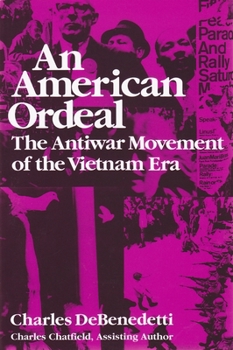American Ordeal: The Antiwar Movement of the Vietnam Era
(Part of the Syracuse Studies on Peace and Conflict Resolution Series)
Select Format
Select Condition 
Book Overview
An American Ordeal is a comprehensive interpretive history that covers the anti-war movement in the USA throughout the entire Vietnam era. This study offers a narrative of the struggle that took place... This description may be from another edition of this product.
Format:Paperback
Language:English
ISBN:0815602456
ISBN13:9780815602453
Release Date:March 1990
Publisher:Syracuse University Press
Length:512 Pages
Weight:1.70 lbs.
Dimensions:1.3" x 6.0" x 9.0"
Customer Reviews
3 ratings
How the policies and protests during the Vietnam War changed America
Published by Thriftbooks.com User , 16 years ago
For a book on this subject, you could do volumes on some of the major topics this book covers. For example: how the Johnson and Nixon Administrations tried to convince Americans to support the war, what the Students on College Campuses did to protest the War and the Draft, the bombings in Cambodia, and so on. At 495 pages, the book covers all that it does in quick synopsis like form, but you still get to understand a bit of what the people in that era was thinking and feeling during the most unpopular war in U.S. history (even though the Iraq War might eclipse that someday if it continues for the next few years.) A quality read, worth the price to purchase.
Great insight into the 60's Antiwar Movement
Published by Thriftbooks.com User , 16 years ago
This was required reading for a graduate course in American history. In An American Ordeal The Antiwar Movement and the Vietnam Era, the authors chronicle the antiwar movement from 1955 to1975. The book gave a sophisticated analysis of the antiwar movement that went beyond some of the tired dichotomies of Communism versus Democracy that are ubiquitous in the historical scholarship of the period. The authors considered the complexity of the antiwar movement with its multitude of factions and how it affected the political atmosphere. The image of the antiwar factions and how the American public felt about the different foreign policies the protestors and the Administration were advocating was described in the book. The period of 1955-1963 was discussed regarding initiatives on nuclear disarmament to slow down or eliminate the nuclear arms race. This period's primary achievement was to focus attention on the issue of atmosphere nuclear testing. After the signing of the Test Ban Treaty in1963, the nuclear disarmament element of the movement began to fade. The civil rights efforts coalesced around the rise of a youthful intellectual left that was more willing to give of themselves to advance the cause of social justice. After 1965, as the Vietnam War intensified, a large portion of these same anti-nuclear and civil rights organizations became part of the opposition to U.S. involvement in Vietnam. Ironically, President Johnson was the peace candidate of the 1964 election and became an intractable hawk on the war. This brought about disillusionment within the movement regarding the strategy of influencing policy makers and, a shift to the strategy of massive demonstrations. The authors maintain that the Vietnam War portion of the 1955-1975 period of peace activism was the most obtuse. The period of 1965-1975 with its concurrent social issues including racial equality and violent domestic unrest was a time of wrenching discord and malaise. The authors believed a dominant theme of the period was the war policy of the Johnson and Nixon administrations versus those that were against intervention in Vietnam. The dynamics of opinion on both sides throughout the period were discussed. The authors pointed out that the desire to cling to executive power by both administrations trumped a clear delineation of policy alternatives for the war. This was the central theme of the book: The withdrawal from the war was the policy option the antiwar movement displayed and ultimate public acceptance of this policy was seen as a sign of the movement's success in that regard. A second theme the authors extensively explained was the division within the antiwar movement. Although a dominant theme in the historical interpretation of the period, the authors saw the dichotomy of us versus them on both sides of the intervention question as simplistic and ultimately unsatisfying in the pursuit of a deep understanding. The authors viewed such a dichotomy as a reflection of the
The ultimate antiwar movement study
Published by Thriftbooks.com User , 23 years ago
This book has been an absolute bible to me in my study of the Antiwar Movement of the Vietnam Era. For anybody studying this period of history, it is of intrinsic value. It details every aspect of the antiwar movement, the cause and consequence of it and lots of other relevant material. Nearly every other modern study of this nature draws a lot from this book. Although DeBenedetti's untimely death leaves the book with a rather ragged finish, its objective analysis is perfect for any historian or student wishing to study the antiwar movement in depth.




